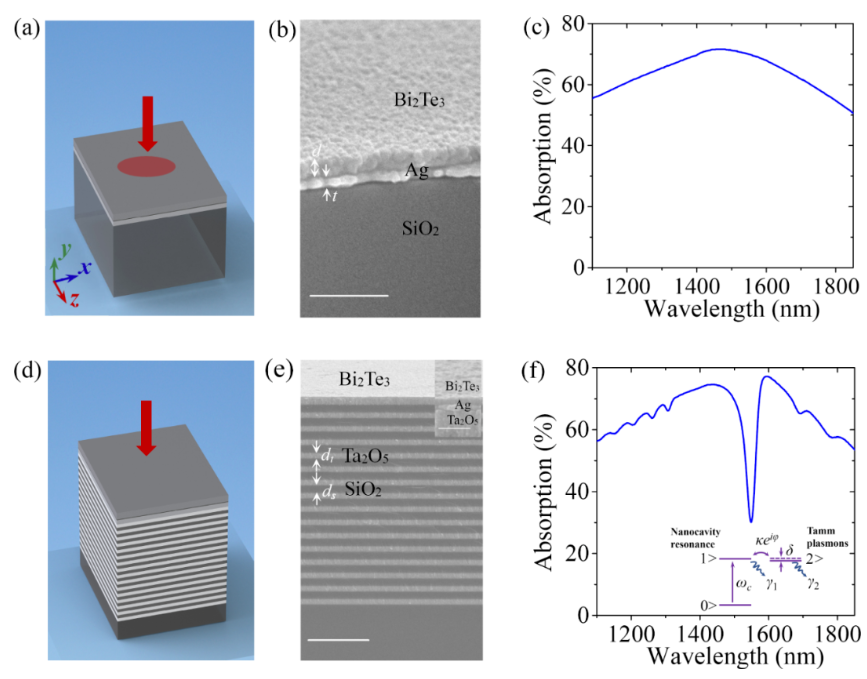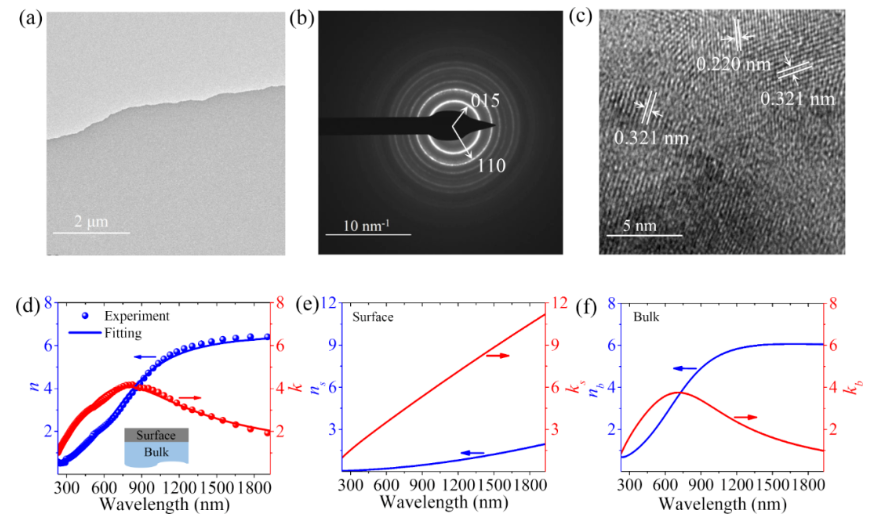Optical communication band, ultra-thin optical resonator
Optical resonators can localize specific wavelengths of light waves in a limited space, and have important applications in light-matter interaction, optical communication, optical sensing, and optical integration. The size of the resonator mainly depends on the material characteristics and the operating wavelength, for example, silicon resonators operating in the near infrared band usually require optical structures of hundreds of nanometers and above. In recent years, ultra-thin planar optical resonators have attracted much attention due to their potential applications in structural color, holographic imaging, light field regulation and optoelectronic devices. How to reduce the thickness of planar resonators is one of the difficult problems faced by researchers.
Different from traditional semiconductor materials, 3D topological insulators (such as bismuth telluride, antimony telluride, bismuth selenide, etc.) are new information materials with topologically protected metal surface states and insulator states. The surface state is protected by the symmetry of time inversion, and its electrons are not scattered by non-magnetic impurities, which has important application prospects in low-power quantum computing and spintronic devices. At the same time, topological insulator materials also show excellent optical properties, such as high refractive index, large nonlinear optical coefficient, wide working spectrum range, tunability, easy integration, etc., which provides a new platform for the realization of light regulation and optoelectronic devices.
A research team in China has proposed a method for the fabrication of ultra-thin optical resonators by using large area growing bismuth telluride topological insulator nanofilms. The optical cavity shows obvious resonance absorption characteristics in near infrared band. Bismuth telluride has a very high refractive index of more than 6 in the optical communication band (higher than the refractive index of traditional high refractive index materials such as silicon and germanium), so that the optical cavity thickness can reach one-twentieth of the resonance wavelength. At the same time, the optical resonator is deposited on a one-dimensional photonic crystal, and a novel electromagnetically induced transparency effect is observed in the optical communication band, which is due to the coupling of the resonator with the Tamm plasmon and its destructive interference. The spectral response of this effect depends on the thickness of the optical resonator and is robust to the change of the ambient refractive index. This work opens up a new way for the realization of ultrathin optical cavity, topological insulator material spectrum regulation and optoelectronic devices.
As shown in FIG. 1a and 1b, the optical resonator is mainly composed of a bismuth telluride topological insulator and silver nanofilms. The bismuth telluride nanofilms prepared by magnetron sputtering have large area and good flatness. When the thickness of the bismuth telluride and silver films is 42 nm and 30 nm, respectively, the optical cavity exhibits strong resonance absorption in the band of 1100~1800 nm (Figure 1c). When the researchers integrated this optical cavity onto a photonic crystal made of alternating stacks of Ta2O5 (182 nm) and SiO2 (260 nm) layers (Figure 1e), a distinct absorption valley (Figure 1f) appeared near the original resonant absorption peak (~1550 nm), which is similar to the electromagnetically induced transparency effect produced by atomic systems.

The bismuth telluride material was characterized by transmission electron microscopy and ellipsometry. FIG. 2a-2c shows transmission electron micrographs (high-resolution images) and selected electron diffraction patterns of bismuth telluride nanofilms. It can be seen from the figure that the prepared bismuth telluride nanofilms are polycrystalline materials, and the main growth orientation is (015) crystal plane. Figure 2d-2f shows the complex refractive index of bismuth telluride measured by ellipsometer and the fitted surface state and state complex refractive index. The results show that the extinction coefficient of the surface state is greater than the refractive index in the range of 230~1930 nm, showing metal-like characteristics. The refractive index of the body is more than 6 when the wavelength is greater than 1385 nm, which is much higher than that of silicon, germanium and other traditional high-refractive index materials in this band, which lays a foundation for the preparation of ultra-thin optical resonators. The researchers point out that this is the first reported realization of a topological insulator planar optical cavity with a thickness of only tens of nanometers in the optical communication band. Subsequently, the absorption spectrum and resonance wavelength of the ultra-thin optical cavity were measured with the thickness of bismuth telluride. Finally, the effect of silver film thickness on electromagnetically induced transparency spectra in bismuth telluride nanocavity/photonic crystal structures is investigated

By preparing large area flat thin films of bismuth telluride topological insulators, and taking advantage of the ultra-high refractive index of Bismuth telluride materials in near infrared band, a planar optical cavity with a thickness of only tens of nanometers is obtained. The ultra-thin optical cavity can realize efficient resonant light absorption in the near infrared band, and has important application value in the development of optoelectronic devices in the optical communication band. The thickness of the bismuth telluride optical cavity is linear to the resonant wavelength, and is smaller than that of similar silicon and germanium optical cavity. At the same time, bismuth telluride optical cavity is integrated with photonic crystal to achieve the anomalous optical effect similar to the electromagnetically induced transparency of atomic system, which provides a new method for the spectrum regulation of microstructure. This study plays a certain role in promoting the research of topological insulator materials in light regulation and optical functional devices.
Post time: Sep-30-2024





